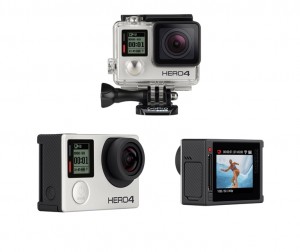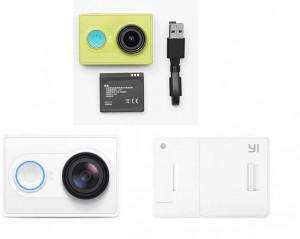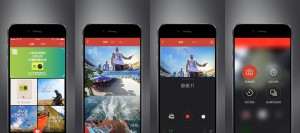Xiaomi Yi and GoPro Hero 4 – Battle of the Action Cameras
Have you ever noticed how some people call every kind of tissue “Kleenex”, even when it’s from another brand? It’s sort of like that with GoPro and action cameras. They are practically synonymous. And there are really good reasons why GoPro is on top. Since the release of the first GoPro in 2012, it has earned a reputation as an action camera with high-video quality and jammed with features. However, those features don’t come cheap.
In response, China’s tech giant, Xiaomi, released its own action camera called Xiaomi Yi. In true Xiaomi style they released a product similar to GoPro but with a smaller price tag. In fact, their product is vastly cheaper than the GoPro Hero 4 Black. You are now probably wondering, can Xiaomi really compete head on with the more established GoPro? In this review, I’ll be comparing Xiaomi Yi with the GoPro Hero 4 Silver (which is currently the cheaper version of their flagship camera, GoPro Hero 4 Black) in order to answer this question.
1st Round: Video and Image Quality
The first and foremost comparison that comes to mind is the video and image quality. In order to attack this, let’s divide the category into several sub-categories: Video Recording, Still Image, Burst Mode, and Time Lapse.
Video Recording
The GoPro Hero 4 Silver is way more expensive than the Xiaomi Yi, so it is rational to expect that it has better video quality. GoPro records 4k videos, which is a resolution of 3840×2160. When recording in this resolution, which is the highest resolution possible, the maximum frame rate will reduce to 15 fps. To compare, most home security cameras offer 30 fps, and higher numbers are better. Of course you can reduce the resolution to increase the frame rate. Unless you are really into recording very high resolution videos, I’d say settling to 1080p videos with 60fps is a great option.
On the other hand, Xiaomi Yi’s maximum resolution is 1080p at 60 fps, which is good enough if you’re not intending to record very high resolution videos. Of course, there’s more to video quality than simply comparing the resolution. Low-light conditions, contrast and crispness, focus, color, and exposure are some of the comparison points between cameras. And when looking at the minute technical specifications, the GoPro Hero 4 Silver defeats Xiaomi Yi. All in all, the Xiaomi is still better than some action cameras like GoPro Hero (GoPro’s entry level camera which costs $129.99) in terms of video quality.
Bottom Line: The GoPro Hero 4 Silver is better than the Xiaomi Yi, but the Yi is a decent camera with good video resolution. Add that to its cheap price, and it becomes a high-value camera.
Still Image
Why do you need an action camera to take a still shot if you already have a DSLR camera or your phone that can capture high quality photos? The answer is simple: Because there are instances where holding out your expensive phone or using a DSLR camera is impractical.
Most action cameras don’t give you the freedom to adjust the way you take photos like a high-end DSLR, but the image quality can compete against entry-level DSLR’s. The Xiaomi Yi captures higher resolution still images than GoPro. The Yi captures 16MP images with a lens view of 155 degrees while GoPro only captures up to 12MP images at 155 degrees. Generally speaking, more pixels equals a better image.
There are other things to consider as well like Night Mode, for example. The GoPro takes better images in low-light conditions than the Yi. The ProtuneT feature is also a nice addition. I mentioned earlier that most action cameras don’t let you adjust the way you capture photos. It is limiting, but not for GoPro. The ProtuneT feature lets you adjust White Balance, ISO Limit, Color, Sharpness, Shutter Speed, and Exposure. More often than not, more flexibility = better.
Bottom Line: The Xiaomi Yi can capture a higher quality still image but the GoPro offers more flexibility through ProtuneT. Tie.
Burst Mode
An important feature for an action camera is Burst Mode. Burst Mode lets you take a series of photos in high speed, capturing every detail of a movement. There are two things we need to look at here: 1. How many pictures can the camera take in a second? 2. Are the pictures high quality? The Xiaomi Yi can take 7 photos in a second. It can be set to take 3p/s (photos per second), 5p/s, 7p/s, or 7p/2s. However, if you think that’s awesome, wait until you see what GoPro can do. It takes 30p/s by default, and you have a wider set of choices including 30p/2s, 30p/3s, 30p/6s, 10p/2,10p/2s, 10p/3s, 5p/s and 3p/s. Having more options allows you to choose the best configuration for the shot(s) you wish to take.
Bottom Line: The Yi uses 16MP for Burst Mode, the GoPro uses 12MP. The GoPro gives you more flexibility and choice and it can take up to 30 photos per second. Thus, this one goes to GoPro.
Time Lapse
If you’re the kind of guy who wants to make Nat-Geo like videos, Time Lapse is for you. Time Lapse videos are a collection of frames captured at an even interval. One obvious difference between the GoPro and the Yi when it comes to Time Lapse is that the GoPro already creates a video out of the frames, while the Yi doesn’t. It is upsetting, because instead of having a finished product within seconds, you’ll have to compile it yourself using video editing software. And if you don’t have editing software handy, you’ll be out of luck.
Bottom Line: The Yi and the GoPro practically offer the same Time Lapse option, except for the part where Yi cannot create a video out of the captured frames without additional editing software. GoPro wins.
Round 2: Design
There are many significant differences between the GoPro and the Yi when it comes to design. Simply, the GoPro looks professional while the Yi looks a little bit like a toy. The Yi comes in yellow, green, or plain white vs the GoPro which comes only in black and silver.
The GoPro Hero 4 Silver is compact, lightweight, and durable. Compared to its predecessor, the Hero 3+ Black, the design is only slightly altered. The buttons remain in the same place less the Wi-Fi button which was changed to Hilight Tag, but it also toggles “Settings” when pressed while not recording. Another significant change is the battery compartment. The opening was previously at the back face of the camera, but GoPro decided to now place it below the camera, where you simply have to slide the lid to open the compartment. The good news is that changing batteries will be quicker. On the other hand, GoPro had to release the camera with new batteries so your older batteries (from previous cameras) won’t fit in. If that upsets you, wait until you see why they moved it – it might change your frown to a smile. Finally, the GoPro Hero 4 Silver was released with a 1.5 inch touch screen that occupies the back face of the camera. This is a game changer. You no longer have to deal with painful minutes trying to configure your camera using buttons, because you can configure it all from the touch screen.
Xiaomi’s products are usually simple in design. The Xiaomi Yi is mostly just plain with 3 buttons, LED indicators, and the lens. The camera is 60.4mm wide, 42mm high and 21.2 mm deep. The three buttons included are:
- Power/Mode switch found on the front-face of the camera just beside the lens. It switches the camera on and changes mode between photo and video.
- Wi-Fi on/off found on the left side of the camera, which does exactly what you think it does.
- Shutter found on the top of the camera. Xiaomi has several slots found at the back face of the camera. It has an HDMI port, USB port, and a memory card slot which supports up to 64GB microSD cards. It has a screw mount for when you want to mount it to your helmet, wrist, or bike. It also has three indicator LED’s. Finally, it has a microphone located on the top of the camera.
Bottom Line: The GoPro retained its professional look. It has a compact and durable design with a touchscreen. GoPro Wins.
Round 3: Key Features
In this section, I’ll be looking at some of the key features available on both cameras.
Touch Display
The touch screen added to the GoPro Hero 4 Silver is a first and makes the camera more user friendly. From the touchscreen you can access settings and navigate camera menus, preview photos or videos to frame the best shot, and playback content. The downside is that a touch screen display can eat up battery life more quickly
The Xiaomi Yi does not have a touchscreen.
Lens Rectification
Most of us love the wide angle field of view produced by action cameras, but there are instances where we want our photos to be natural and without the barrel roll distortion (fish-eye view) effect. For most action cameras, you can doctor this post-production. Wit GoPro this can be done using GoPro Studio.
The Xiaomi Yi offers a Lens Rectification feature. When switched on, it will remove the barrel roll distortion and switch to the normal view without the need for post-production editing.
Video Rotate
Just like the Lens Rectification, there are instances where you want or need to rotate your video upside down. Both cameras offer the option to do so. You can rotate on the GoPro by adjusting settings on the camera. You can rotate on the Yi by changing the setting in the camera’s app.
Auto Low-Light
Both of cameras offer the Auto Low-Light feature. GoPro’s Auto Low-Light mode intelligently changes frame rates based on the light conditions, so taking a video or photo from bright to dark environments and vice versa will be easier. The Auto Low-Light mode of the Xiaomi Yi is different, perhaps it should only be called Low-Light mode. It does not automatically change its performance in low-light, but offers a manual process instead.
ProtuneT
ProtuneT is a trademark feature of the GoPro and is available for both photo and video modes. This feature, which is absent in Yi, let’s you unlock the real potential of a GoPro. It gives you power to adjust and readjust your settings. It relies mainly on your creativity and skill as well as your ability to manually control your camera. This is a nice feature, especially for cinema-caliber production videos and when you need to adjust your ISO Limit, Shutter Speed, Exposure, Color, Sharpness, White Balance, etc.
QuikCapture Convenience
With the QuikCapture feature, you will be able to power on and start recording using your GoPro with the press of a single button. Simply press it once to record a video and press and hold for 2 seconds to capture Time Lapse photos.
HiLight Tag
Many action camera users have been stuck for hours searching for that epic shot they took. Or have you ever recorded a long video but wanted to find “that ones special moment”? It’s tough but don’t worry, GoPro has you covered. They offer the HiLight Tag feature where with a press of a button, it bookmarks your epic shot so it’s easier to track down later.
Bottom Line: The GoPro has outdone Xiaomi when it comes to features, but what would you expect from a camera that is much more expensive? The GoPro features are awesome and very convenient. However, to be fair, the Xiaomi Yi also has cool features like Lens Rectification. The Xiaomi Yi is very simple, easy to manipulate, and has limited features, so it is nice for beginners. Tie.
Round 4: Battery Life
The compact design of action cameras limits its producers from putting in higher battery standards with longer battery life. The GoPro Hero 4 Silver, for example, only has a 1160mAh lithium-ion battery. A battery like that can power the camera for 2 hours with Wi-Fi off. Turning on the Wi-Fi or using the GoPro app significantly reduces its battery life.
Xiaomi Yi uses a LiPo battery which is 1010mAh. It allows up to 2 hours of 1080p 30fps recording with the Wi-Fi switched on.
If you want to record videos which are longer than 2 hours, both Xiaomi and GoPro offer accessories to make that happen.
Bottom Line: There’s not much of a difference in their battery life. Considering that GoPro has more features consuming more power than the Xiaomi Yi, it is normal that Xiaomi can stand as long or even outlast GoPro. Tie.
Round 5: Apps
The Xiaomi Yi has a mobile app that now supports Android and iOS users (some additional details can also be found on the Xiaoyi website). Once installed, the app controls everything about the camera. You can set the video resolution, default camera mode, number of shots in Burst Mode, intervals in Time Lapse, etc. You can also stream your camera live when it’s connected to Wi-Fi.
The GoPro app supports Android and iOS and works as a remote control, viewer, and social media for GoPro users. You can control your camera’s settings from the app (camera must be Wi-Fi connected), preview your camera to frame a good shot, watch you Hilight Tag videos, and share your favorite videos and photos with the world.
Bottom Line: GoPro’s app is better and more refined than Xiaomi’s. GoPro wins.
Round 6: Accessories
The GoPro Hero 4 Silver can be heavily accessorized:
- Battery BacPac- A removable battery pack that attaches to your GoPro for extended battery life.
- Smart Remote- Long-range remote control to control the mode, setting, and recording of your GoPro.
- Dual Battery Charger- A charger that charges two batteries simultaneously.
- The Tool- A thumb screw wrench for your GoPro’s mountings that also doubles as a bottle opener.
- Floaty Backdoor- An easy-to-spot floatation that keeps your GoPro floating.
- Protective Lens- Protects your lens from scratch and dust.
- Skeleton Housing/ Dive Housing/ Standard Housing- A protective housing that keeps your GoPro safe from scratch, dust, and even water.
- Dive Filters- Gives color correction when diving to achieve the natural color even when underwater.
There are a lot more accessories for a GoPro Hero 4 Silver, but the rest that I haven’t mentioned are mostly just extra wires, cables, and microSD cards.
By comparison, the Xiaomi Yi currently only has 7 accessories.
- Waterproof Case- A thin, see-through plastic case that seals the camera in, not allowing water or moisture to pass through.
- Silicone Case- It protects the camera from water splash, moisture, dust, and scratches.
- Fixing Strap- A strap that allows your camera to be mounted on your body or pet.
- Hand Mount- Just like the fixing strap but this one mounts your camera to your wrist.
- Lens Cover- A cap that protects your lens from dust, scratch, and moisture.
- Head Strap- A strap that mounts Yi to your head, allowing hands-free shooting.
- Bike or Motorcycle Mount- Allows you to securely attach your Yi to a bicycle or motorcycle.
Bottom Line: I’m not calling a winner here. It just depends upon what accessories you want or don’t want.
Final Round: Price
And last, the price. The Yi can be had for below $100 (available at Amazon) while the GoPro Hero 4 Silver costs $399.99 (available at Amazon).
Bottom Line: The Yi wins.
Concluding Thoughts
There are rumors spreading around the Internet that Yi is a GoPro Killer. Apparently, that’s an o verstatement. The Yi has some nice features, but the only thing it “kills” is the GoPro price tag. The GoPro is definitely a better camera, but if you want an entry-level action cam, it might be worth to check out the Yi. If you have comments or questions regarding this article, please post them below or start a new thread in our community forum.
This article was contributed by aSecureCam.com. Visit them for the best video surveillance reviews online.





















4 thoughts on “Xiaomi Yi and GoPro Hero 4 – Battle of the Action Cameras”
Seems like a pretty biased comparison. Looks like the reviewer goes out of his way to not give any points to xiaomi. Basically calling parts where xiaomi wins ties.
I am going to say I am biased towards the Yi, but I really think this article shouldn’t be biased. There are a lot of great features the Yi offers compared to the GoPro that make it a much better option than the GoPro. And not just the pricetag.
If you are a viewer reading this article and you are now considering to buy a gopro, I honestly suggest you look into a different comparison too. I wouldn’t trust it from just this article.